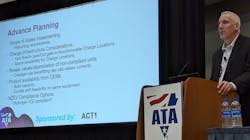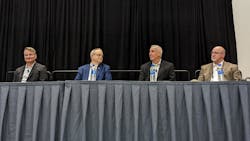Trucking environmental regs put industry at 'inflection point'
More environmental regulations have and will be adopted within a 10-year window than the trucking industry has seen over the past 30 years. While the California Air Resources Board considers its stringent Advanced Clean Fleet regulation, more states across the country are considering similar rules that would phase out traditional internal combustion engines from freight transport.
"We're truly at an inflection point in our industry today," Glen Kedzie, VP of energy and environmental counsel at American Trucking Associations, said. "Forthcoming EPA and CARB NOx engine emission standards, truck greenhouse gas and fuel efficiency standards, the march towards zero-emission vehicles and likely future internal combustion engine bans have created a new road map—unlike anything we have ever seen in our industry."
Most impending regulations—such as GHG Engine Phases 2 and 3, Omnibus NOx, and Advanced Clean Trucks— are aimed at engine and truck manufacturers. "But we always have a saying that while regulations are directed at the manufacturers, it is the fleets that determine the success or failure of these regulations," Kedzie said. "Namely, whether or not they purchase the equipment, how much of the equipment they purchase, and the timing of those purchases."
Roundup: ATA's MC&E 2022 turns attention to trucking's futureKedzie moderated a panel during ATA's Management Conference & Exhibition 2022 in San Diego last week that featured fleet and manufacturing executives who broke down the pending regulations and potential roadmaps to compliance.
With truck OEMs just beginning to introduce zero- and low-emission heavy-duty equipment to the market, fleets should start planning now for if the Advance Clean Fleet rule passes, according to panelists Dan Porterfield, SVP of maintenance and equipment control at Covenant Logistics (No. 54 on FleetOwner 500: For-Hire.)
Why fleets need to plan now for future regulations
"There's not a lot of meat out there right now," Porterfield said. "The OEMs are building them; they're getting them ready for us; they're putting them in the market. But it's not like you can just go and buy 20 of these today; they're not available. You need to start planning ahead. This is going to be coming at us fast. So you need to be thinking, how do I get information and knowledge and skills. Sometimes that just requires experience."
Most OEMs didn't begin full production of Class 8 EVs until the past year. And build rates are not as robust as for traditional heavy equipment thanks to supply constraints and other factors.
See also: NACFE sets sights on electric depots for next Run
The proposed CARB rule, known as ACF, aims to ban medium- and heavy-duty diesel and gasoline vehicle sales by 2040. Leading up to that, CARB wants to limit how many non-ZEVs fleets can purchase. The proposal categorizes vehicle requirements into high priority and federal, drayage, and state and local government fleets. (See details on how California wants to limit those fleet categories.)
The CARB Omnibus NOx standards, finalized in 2021, take effect for model year 2024 equipment in California. Other states, such as Oregon, Washington, New York, and Massachusetts, are looking to implement similar standards by MY 2026. Seventeen states have already signed memorandums of understanding calling for zero-emission commercial vehicle regulations that mimic California's rigorous standards.
California is still waiting for the U.S. EPA to permit it to implement the regulation, according to Matthew Spears, executive director for global regulatory affairs at Cummins. "So there is still some uncertainty as to whether or not this will be implemented in 2024," he cautioned. "But at this point in time, all manufacturers and fleets should best plan for it to be implemented."
Tighter regulations start with manufacturers
He said that even if the EPA does grant the waiver to enforce the state law, court challenges could slow the implementation. "They really did take pretty much every element of their regulations and make them tighter and more stringent—more stringent NOx standards, more stringent PMs (particulate matter) standards, longer useful life, longer warranty, more comprehensive in-use test procedures," Spears said. "All of these are ultimately directed at the engine manufacturer, who certifies and assures compliance for the emission standards for the tailpipe emissions that come out of that product."
While engine makers, such as Cummins, work on zero-emission power beyond battery-electric vehicles, most ZEVs available today are electric. Ron Hall, SVP of equipment and fuel at C.R. England, noted that the pending Advance Clean Fleet regulations require carriers to start working on charging infrastructure and procurement early to qualify for any regulations extensions down the road. (C.R. England is No. 34 on FleetOwner 500: For-Hire.)
"This isn't a situation where three months before the regulation is due to implement and you can't get either the truck or the utility infrastructure and then apply for an extension," Hall explained. "You actually have to do that in advance."
And, he noted, demand for ZE tractors will only intensify. "I would encourage folks to start talking to their OEMs quickly," Hall said.
Working with OEMs isn't just about planning out future procurement. It's also about understanding the impending patchwork of emissions regulations across North America, according to Johan Agebrand, director of product marketing at Volvo Trucks North America.
"You need to work very closely with your dealerships, and the dealerships need to work closely with the OEMs," he said.
Agebrand noted the thousands of pages of regulations include various nuances that OEMs and truck dealers can help fleets navigate.
About the Author
Josh Fisher
Editor-in-Chief
Editor-in-Chief Josh Fisher has been with FleetOwner since 2017. He covers everything from modern fleet management to operational efficiency, artificial intelligence, autonomous trucking, alternative fuels and powertrains, regulations, and emerging transportation technology. Based in Maryland, he writes the Lane Shift Ahead column about the changing North American transportation landscape.





